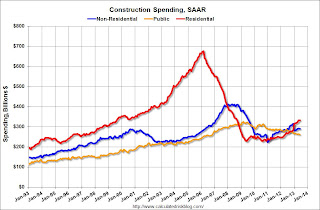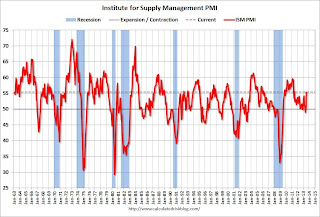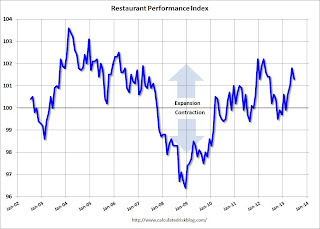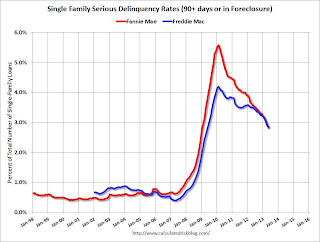From the Calculated Risk Blog
Calculated Risk Construction Spending declined in June, Public Construction Spending at Lowest Level since 2006 ISM Manufacturing index increases in July to 55.4 Weekly Initial Unemployment Claims decline to 326,000 Thursday: Vehicle Sales, Unemployment Claims, ISM Mfg Index, Construction Spending Fannie Mae: Mortgage Serious Delinquency rate declined in June, Lowest since December 2008 FOMC Statement: ...
Calculated Risk |
- Construction Spending declined in June, Public Construction Spending at Lowest Level since 2006
- ISM Manufacturing index increases in July to 55.4
- Weekly Initial Unemployment Claims decline to 326,000
- Thursday: Vehicle Sales, Unemployment Claims, ISM Mfg Index, Construction Spending
- Fannie Mae: Mortgage Serious Delinquency rate declined in June, Lowest since December 2008
- FOMC Statement: Downgrade from “moderate” to “modest”
| Construction Spending declined in June, Public Construction Spending at Lowest Level since 2006 Posted: 01 Aug 2013 08:55 AM PDT The Census Bureau reported that overall construction spending declined in June:
This graph shows private residential and nonresidential construction spending, and public spending, since 1993. Note: nominal dollars, not inflation adjusted. Private residential spending is 51% below the peak in early 2006, and up 45% from the post-bubble low. Non-residential spending is 30% below the peak in January 2008, and up about 29% from the recent low. Public construction spending is now 20% below the peak in March 2009 and at the lowest level since 2006.
On a year-over-year basis, private residential construction spending is now up 23%. Non-residential spending is up slightly year-over-year. Public spending is down 9.3% year-over-year. A few key themes: 2) Private non-residential construction spending usually lags the economy. There was some increase this time for a couple of years – mostly related to energy and power – but the key sectors of office, retail and hotels are still at very low levels. I expect private non-residential to start to increase later this year. 3) Public construction spending decreased in June. Public spending has declined to 2006 levels (not adjusted for inflation) and has been a drag on the economy for 4 years. In real terms, public construction spending has declined to 2001 levels. The good news going forward is 1) private residential construction spending is still very low and will probably continue to increase over the next few years, 2) Private non-residential spending appears about to increase (see forecast from American Institute of Architects, and 3) public construction spending is probably close to a bottom. |
| ISM Manufacturing index increases in July to 55.4 Posted: 01 Aug 2013 07:05 AM PDT The ISM manufacturing index indicated faster expansion in July. The PMI was at 55.4% in July, up from 50.9% in June. The employment index was at 54.4%, up from 48.7%, and the new orders index was at 58.3%, up from 51.9% in June. From the Institute for Supply Management: July 2013 Manufacturing ISM Report On Business®
Here is a long term graph of the ISM manufacturing index. This was above expectations of 53.1% and suggests manufacturing expanded at a faster pace in July. |
| Weekly Initial Unemployment Claims decline to 326,000 Posted: 01 Aug 2013 06:00 AM PDT The DOL reports:
The previous week was revised up from 343,000. The following graph shows the 4-week moving average of weekly claims since January 2000.
The dashed line on the graph is the current 4-week average. The four-week average of weekly unemployment claims decreased to 341,250. The 4-week average has mostly moved sideways over the last few months, and is near the low for the year. Claims were below to the 345,000 consensus forecast. |
| Thursday: Vehicle Sales, Unemployment Claims, ISM Mfg Index, Construction Spending Posted: 31 Jul 2013 05:29 PM PDT Restaurant spending is discretionary, so even though this is “D-list” data, I like to check it every month. From the National Restaurant Association: Despite June Decline, Restaurant Performance Index Remains Steadily Positive
The index decreased to 101.3 in June from 101.8 in May. (above 100 indicates expansion). Thursday: • All day: Light vehicle sales for July. The consensus is for light vehicle sales to decrease to 15.8 million SAAR in July (Seasonally Adjusted Annual Rate) from 15.9 million SAAR in June. • At 9:00 AM, The Markit US PMI Manufacturing Index for July. The consensus is for the index to increase to 53.1 from 51.9 in June. • At 10:00 AM, the ISM Manufacturing Index for July. The consensus is for an increase to 53.1 from 50.9 in June. Based on the regional surveys, an increase in July seems likely. The ISM manufacturing index indicated expansion in June at 50.9%. The employment index was at 48.7%, and the new orders index was at 51.9%. • Also at 10:00 AM, Construction Spending for June. The consensus is for a 0.4% increase in construction spending. |
| Fannie Mae: Mortgage Serious Delinquency rate declined in June, Lowest since December 2008 Posted: 31 Jul 2013 01:11 PM PDT Fannie Mae reported today that the Single-Family Serious Delinquency rate declined in June to 2.77% from 2.83% in May. The serious delinquency rate is down from 3.53% in June 2012, and this is the lowest level since December 2008. The Fannie Mae serious delinquency rate peaked in February 2010 at 5.59%. Earlier Freddie Mac reported that the Single-Family serious delinquency rate declined in June to 2.79% from 2.85% in May. Freddie’s rate is down from 3.45% in June 2012, and is at the lowest level since May 2009. Freddie’s serious delinquency rate peaked in February 2010 at 4.20%. Note: These are mortgage loans that are “three monthly payments or more past due or in foreclosure”.
Although this indicates progress, the “normal” serious delinquency rate is under 1%. At the recent rate of improvement, the serious delinquency rate will not be under 1% until 2016 or so. |
| FOMC Statement: Downgrade from “moderate” to “modest” Posted: 31 Jul 2013 12:02 PM PDT Economic activity downgraded and more concern about inflation too low (update: added “too low).
|






